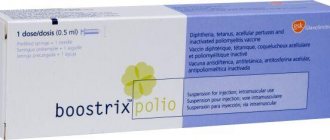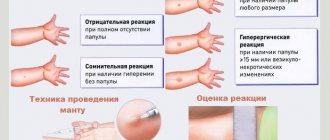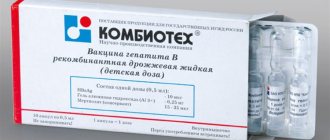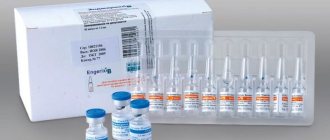Release form, composition and packaging
| Suspension for intramuscular administration | 0.5 ml |
| HBS protein, which is the main surface antigen of the hepatitis B virus (HBsAg) | 20 mcg |
| diphtheria toxoid | 10 Lf |
| tetanus toxoid | 10 EC |
0.5 ml - ampoules (10) - contour cell packaging (1) - cardboard packs.
BUBO-M: DOSAGE
Bubo-M vaccine is administered intramuscularly into the deltoid muscle in a single dose of 0.5 ml.
Before vaccination, the ampoule must be thoroughly shaken until a homogeneous suspension is obtained.
Subcutaneous administration of the drug and injection into the gluteal muscle are not recommended due to a decrease in the effectiveness of the hepatitis component and the possibility of increased local reactions.
Primary vaccination of children over 6 years of age and adolescents who have not previously been vaccinated against diphtheria, tetanus and hepatitis B is carried out three times according to the scheme: 1st dose - on the selected day, 2nd dose - after 1 month, 3rd dose - after 6 months after the first dose.
If it is necessary to increase the intervals, vaccination should be carried out as soon as possible, determined by the health status of the vaccinee. By increasing the interval between the first and second vaccination by 5 months. and more than the third vaccination is carried out no earlier than 1 month later. after the second one. Subsequent revaccinations with ADS-M toxoid are carried out in accordance with the vaccination calendar.
Revaccination of persons who have previously received vaccinations against diphtheria and tetanus, but not vaccinated against hepatitis B, is carried out once, followed by vaccination with hepatitis B vaccine for the missing vaccinations against hepatitis B in an age-specific dosage.
The drug is not suitable for use in ampoules with damaged integrity, lack of labeling, changes in physical properties (change of color, presence of non-developing flakes), expired expiration date, or improper storage.
For injections, only a disposable syringe is used.
The opening of ampoules and the vaccination procedure are carried out in strict compliance with the rules of asepsis and antiseptics. The drug cannot be stored in an opened ampoule. The administration of the drug is registered in the established accounting forms, indicating the batch number, control number, expiration date, manufacturer, and date of administration.
Preventive vaccinations
When can you get vaccinated and when not?
A few important vaccination rules:
- All family members of the person receiving the vaccine must be healthy
- When vaccinating children, new complementary foods cannot be introduced at the same time.
- You should not vaccinate a teething baby.
- Vaccinations are given no earlier than a month after recovery.
- If your child has allergies, start taking antiallergic medications (for example, Zyrtec, Fenistil, etc.) 3 days before vaccination.
- After vaccination, do not leave immediately. Try to sit for another 30-40 minutes near the doctor's office
- Do not take a bath on the day of vaccination
- After vaccinations, you should avoid crowded places, as the likelihood of getting infected is higher.
Vaccination calendar
| CHILD'S AGE | NAME OF VACCINATION |
| NEWBORN IN THE 1ST 24 HOURS OF LIFE | VACCINATION AGAINST HEPATITIS B (V 1 HBV) |
| NEWBORN IN THE 1ST 3-7 DAYS OF LIFE | VACCINATION AGAINST TUBERCULOSIS (BCG V) |
| 1 MONTH | VACCINATION AGAINST HEPATITIS B (V 2 HBV) |
| 2 MONTHS | VACCINATION AGAINST PNEUMOCOCCAL INFECTION (V1) + V3 HBV (RISK GROUND) |
| 3 MONTHS | VACCINATION AGAINST WHOOPING COUGH, DIPTHERIA, TENETUS (V1 DTP) + AGAINST POLIOMYELITIS (V1 IPV) + AGAINST HEMOPHILIUS INFECTION (V1) |
| 4.5 MONTHS | V2 DTP + V2 IPV + V2 PNEUMOCOCCAL INFECTION + V2 HEMOPHILIAN INFECTION |
| 6 MONTHS | V3 DPT + V3 PPV +V3 HBV + V3 HEMOPHILI INFECTION |
| 12 MONTHS | R. MANTOU, VACCINATION AGAINST MEASLES, MUMPS, RUBELLA (V) +V4 HBV (RISK GROUND) |
| 15 MONTHS | REVACCINATION AGAINST PNEUMOCOCCAL INFECTION (RV) |
| 18 MONTHS | RV1 DPT, RV1 PPV, RV HEMOPHILI INFECTION |
| 20 MONTHS | RV2 PPV |
| 6 YEARS | RV MEASLES, MUMPS, RUBELLA |
| 6-7 YEARS | RV2 ADS-M, RV1 BCG |
| 14 YEARS | RV3 DTP, RV3 PPV |
670042, Republic of Buryatia, Ulan-Ude, st. Tobolskaya, 155
Official website address: gp3uu.ru
Call center: 29-73-60
Children's clinic: 29-76-20
Women's consultation: 29-76-10
Emergency medical center from 08.00 to 20.00 (except Sunday): 51-76-15 29-76-15
Deputy Chief Physician for providing medical care to children: 55-60-48
Deputy chief physician for quality control and safety of medical activities: 29-73-69
Hotline: 69-00-41
One of the most important measures taken to preserve and strengthen the health of children is the organization and implementation of preventive vaccinations.
Vaccination is the most effective and cost-effective means of protection against infectious diseases known to modern medicine.
INFECTIONS AGAINST WHICH CHILDREN CAN BE PROTECTED BY VACCINATION
Poliomyelitis is a disease that affects the central nervous system, primarily the spinal cord, and leads to the development of paralysis, leading to disability.
Hepatitis B is a disease characterized by inflammatory damage to the liver. Viral hepatitis B transmitted at an early age in 50-90% of cases becomes chronic, leading subsequently to liver cirrhosis and primary liver cancer.
Tuberculosis is a disease that affects the lungs and bronchi, but other organs may also be affected. With tuberculosis, the development of generalized forms is possible, incl. and tuberculous meningitis resistant to anti-tuberculosis drugs.
Whooping cough is a respiratory tract disease. A serious complication is encephalopathy, which, due to seizures, can lead to death or leave behind permanent damage, deafness or epileptic seizures.
Diphtheria is a disease characterized by toxic damage to the body, mainly the cardiovascular and nervous systems, as well as a local inflammatory process with the formation of fibrin plaque. Complications such as infectious-toxic shock, myocarditis, polyneuritis, including damage to the cranial and peripheral nerves, damage to the adrenal glands, and toxic neurosis are possible.
Tetanus - affects the nervous system and is accompanied by high mortality due to paralysis of the respiratory tract and heart muscle.
Measles is a disease that can cause the development of otitis media, pneumonia that does not respond to antibiotic therapy, and encephalitis. The risk of severe complications and death is especially high in young children.
Mumps - the disease can be complicated by serous meningitis, and in some cases inflammation of the pancreas. Mumps is one of the causes of male and female infertility.
Pneumococcal infection is the cause of most pneumonia (including severe ones), some meningitis and septic conditions. The relevance is evidenced by the fact that the vaccine is present in the national calendars of more than 40 countries.
Haemophilus influenzae infection is a series of acute infectious diseases caused by Haemophilus influenzae. Purulent meningitis (inflammation of the membranes of the brain or spinal cord), otitis media (purulent inflammation of the middle ear), pneumonia, septicemia (blood poisoning), purulent arthritis and joint problems.
INFECTIONS AND HOW TO PROTECT FROM THEM
1. Tuberculosis - BCG, BCG-M
2. Diphtheria - ADS, ADS-M, AD-M, DTP, "Bubo-M", "Bubo-Kok", "Infanrix", "Pentaxim", "Tetraxim", "Infanrix Penta", "Infanrix Hexa"
3. Tetanus - tetanus toxoid, DTP, ADS, ADS-M, "Pentaxim", "Bubo-Kok", "Bubo-M", "Infanrix Hexa", "Tetraxim",
4. Whooping cough - DTP, "Bubo-M", "Bubo-Kok", DTP-GepV, "Pentaxim", "Infanrix Penta", "Infanrix Hexa", "Tetraxim", "Infanrix".
5. Measles - Live measles cultural vaccine, live mumps-measles cultural vaccine, "Priorix", M-M-R II.
6. Influenza - “Ultravac”, “Ultrix”, “Microflu”, “Fluvaxin”, “Vaxigrip”, “Fluarix”, “Begrivac”, “Influvac”, “Agrippal S1”, “Grippol plus”, “Grippol”, "Inflexal V", "Sovigripp".
7. Hemophilus influenzae type b - Hib "Act-HIB", "Hiberix Pentaxim", hemophilus influenzae type B conjugated, "Infanrix Hexa".
8. Rubella - Live rubella vaccine, attenuated live rubella vaccine, Priorix, MMP-II.
9. Hepatitis B - “Euvax B”, “Vaccine against hepatitis B recombinant”, “Regevac B”, “Engerix B”, vaccine “Bubo-Kok”, “Bubo-M”, “Shanvak-B”, “Infanrix Hexa” ", "DPT-GEP V".
10. Hepatitis A - “Avaxim”, “Avaxim 80”, “Vakta”, “Havrix 720”, “Havrix 1440”.
11. Poliomyelitis - “Infanrix Hexa”, “Pentaxim”, oral polio vaccine types 1, 3, “Imovax Polio”, “Poliorix”, “Tetraxim”.
12. Mumps - Mumps-measles culture (live), mumps culture (live), "Priorix", MMP-II.
13. Pneumococcal infection - “Pneumo-23”, 13-valent “Prevenar 13”, 10-valent “Synflorix”.
14. Human papillomavirus / CC “Gardasil”, “Cervarix”.
15. Rotavirus infection - RotaTek.
16. Meningococcal infection - Meningococcal group A vaccine, polysaccharide dry, polysaccharide meningococcal vaccine A+C, "Menactra", "Mencevax ACWY", "Meningo A+C",
Currently, there are vaccines against such dangerous infections as HPV (human papillomavirus), chickenpox and rotavirus and meningococcal infections.
In our clinic there is the possibility of alternative vaccination, namely paid vaccination with imported vaccines against rotavirus infection, chicken pox, etc. You can get detailed information from your local doctor or nurse.
Author: Timofeeva E. N., Zhigzhitova E. V.
*This document is the intellectual property of the State Budgetary Healthcare Institution “City Clinic No. 3” and cannot be fully or partially reproduced, replicated or used in any other way without the permission of the State Budgetary Healthcare Institution “City Clinic No. 3”.
You can find more information at Vaccination Specialists
BUBO-M: SIDE EFFECTS
Side effects from the vaccine are rare. In 3-5% of vaccinated people, short-term general (fever, malaise, joint and muscle pain, dizziness) and local (pain, hyperemia, swelling) reactions may develop in the first two days.
In extremely rare cases, allergic reactions may develop (Quincke's edema, urticaria, polymorphic rash), a slight exacerbation of allergic diseases. Considering the possibility of developing immediate allergic reactions in particularly sensitive individuals, vaccinated individuals must be provided with medical supervision for 30 minutes.
Vaccination sites must be provided with anti-shock therapy.
Side effects and complications
Vaccination with the Bubo-M vaccine is tolerated quite well. The combination of diphtheria and tetanus toxoids and hepatitis B antigen does not increase, but, on the contrary, reduces the number of side effects. With simultaneous separate vaccination with ADS-M and hepatitis B vaccine, the frequency of adverse reactions is 58%, and with the introduction of Bubo-M - only 26%. Local reactions to the administration of the Bubo-M vaccine, such as redness, pain, swelling at the injection site, as well as general reactions - fever, malaise, fatigue, muscle pain, dizziness - occur in 3-5 people out of 100. These symptoms are not very pronounced , do not pose any serious danger and disappear on their own within 2–3 days.
The manufacturer of the vaccine also warns about the possibility of allergic reactions - angioedema, urticaria, itching, anaphylactic shock. Although no such reactions were noted during the studies. The vaccine does not cause any serious complications.
The consequence of vaccination is the formation of immunity against tetanus, diphtheria and hepatitis B. The effectiveness of vaccination is 100% after the entire course of primary immunization. Clinical studies of the Bubo-M vaccine have shown greater effectiveness of its tetanus and diphtheria components compared to ADS-M.
Bubo-M has no analogue vaccines. To achieve the same result, you can only get vaccinated separately - against hepatitis B and ADS-M.
Let's summarize. Considering that hepatitis B is spreading at a tremendous rate, it is recommended that all categories of people, from children to adults, be vaccinated against it. And tetanus is a well-known dangerous disease. You need to be vaccinated against these diseases from childhood. But you cannot stop immunization when you enter adulthood, because immunity is formed only for 10 years, and for the rest of your life the body is defenseless against these dangerous infections. In order not to administer the anti-hepatitis vaccine separately, you can combine it with a routine revaccination against tetanus and diphtheria by vaccinating with the Bubo-M vaccine, which has been clinically proven to be effective, and side effects are rarely observed after it.
Indications
Prevention of hepatitis B, diphtheria and tetanus in children over 6 years of age, adolescents and adults.
Bubo-M vaccine is used:
- when conducting a vaccination course for children over 6 years of age,
- not previously vaccinated against diphtheria,
- tetanus and hepatitis B;
- for planned age-related revaccinations (according to the ADS-M application regimen) for children over 6 years of age,
- teenagers and adults,
- not previously vaccinated against hepatitis B;
- when the timing of revaccination of children and adolescents against diphtheria and tetanus coincides with one of the vaccinations of the hepatitis B vaccine course.
Reviews
Yuri : I am very careful about all kinds of vaccines, especially Russian ones - I’m afraid of complications. Therefore, before getting vaccinated with the recommended vaccine, I googled Bubo m vaccine instructions for use and received comprehensive information.
Having made up my mind, I did not regret my choice. There wasn’t even the slightest bit of discomfort, and I slept peacefully at night. I hope my review is useful to someone.
Svetlana, 33 years old : A doctor from a paid clinic recommended Bubo-M, especially since her daughter’s vaccinations were due. I wrote on the medical website: bubo m vaccine reviews and was satisfied with the properties of the drug.
However, literally a few hours after the injection, my child began to breathe heavily, and after some time her temperature rose to 40 degrees. Moreover, it was not easy to bring down the temperature.
Nurofen did not help at all and I had to use rectal suppositories. I managed to fall asleep only in the morning. The general malaise lasted about a week.
Contraindications
Contraindications to the use of Bubo-M vaccine are strong (temperature above 40°C, swelling, hyperemia more than 8 cm in diameter at the injection site) and unusual reactions to previous administration of diphtheria-tetanus toxoid or hepatitis B vaccine, as well as allergic reactions to yeast and other vaccine components.
Routine vaccination is postponed until the end of acute manifestations of the disease and exacerbation of chronic diseases.
For mild ARVI, acute intestinal diseases, etc., vaccinations are carried out immediately after the temperature normalizes.
Patients with chronic diseases are vaccinated upon achieving complete or partial remission. Persons with neurological changes are vaccinated after progression of the process has been ruled out. For patients with allergic diseases, vaccinations are carried out 2-4 weeks after the end of the exacerbation, while stable manifestations of the disease (localized skin phenomena, hidden bronchospasm, etc.) are not contraindications to vaccination, which can be carried out against the background of appropriate therapy.
Pregnancy. The effect of the vaccine on the fetus has not been studied. The possibility of vaccinating a pregnant woman can be considered individually.
Immunodeficiencies, HIV infections, as well as maintenance course therapy, including steroid hormones and psychopharmaceuticals, are not contraindications to vaccination.
In order to identify contraindications, the doctor (paramedic at the FAP) on the day of vaccination conducts a survey of parents and an examination of the vaccinated with mandatory thermometry. When vaccinating adults, a preliminary selection of persons to be vaccinated is allowed, followed by a survey of them by the medical worker conducting the vaccination using thermometry on the day of vaccination. Persons temporarily exempt from vaccination must be monitored and registered and vaccinated in a timely manner.
Combined vaccine Bubo-M: instructions for use, analogues and reviews
Bubo-M is a separate combination vaccine designed to fight diseases such as hepatitis B, diphtheria and tetanus. The product is included in the vaccination calendar and is indicated for immunization of persons from 6 years of age with subsequent vaccination of adolescents and adults at risk.
Release form and composition
The drug is produced in the form of ampoules containing half a milliliter. One package should contain exactly ten ampoules located in contour cells.
One dose of the vaccine contains:
The vaccine has a light yellow tint. When standing for a long time, the suspension separates into a clear liquid and loose sediments that fall down. Shaking the ampoule returns the vaccine to its normal state.
Vaccine technology
The main active ingredient of the vaccine is a purified combined antigen, which is produced by combining three elements:
- diphtheria and tetanus toxoids (that is, neutralized toxins) purified;
- recombinant hepatitis B antigen (HBsAg).
All these substances are sorbed on aluminum hydroxide, creating an improved remedy for combating viral diseases.
What is Bubo-M vaccinated against?
The main purpose of the Bubo-M vaccine is the effective prevention of hepatitis B, as well as diphtheria and tetanus.
The vaccine is prescribed to children over six years of age who have not previously been vaccinated against the above diseases.
It is also used for routine vaccinations of adolescents and adults.
Instructions for use of the Bubo-M vaccine
The recommended use of the vaccine is intramuscular, in the shoulder. Before grafting, the ampoule is thoroughly shaken until a homogeneous (without foreign inclusions) suspension is obtained.
The manufacturer does not recommend subcutaneous administration (or in the buttock area), since the effectiveness of the hepatitis component of the drug in this case is reduced and the risk of side effects increases. Single dose – 0.5 ml.
Primary vaccination of children after 6 years of age, adolescents and adults involves a 3-fold course:
- 1 injection – the timing is agreed upon by the doctor together with the parents (if the baby is being vaccinated) taking into account the vaccination schedule;
- 2nd dose – a month later (relative to the 1st vaccination).=;
- 3rd injection – six months from the start of the course.
Before and after the procedure, it is important for the child to follow a gentle regimen for several days:
- If possible, undergo general tests. This will help identify an incipient (but still asymptomatic) disease;
- avoid crowded places;
- on the day of the procedure, the vaccinator must be healthy;
- Do not feed your baby unfamiliar foods the day before to avoid possible allergies. The child’s usual diet should also be followed in the post-injection period (3-4 days);
- The injection site should be protected from moisture in the next 24 hours.
Do not hesitate to ask the medical staff to show you the ampoule that you plan to use. Examine it for integrity, and the contents for uniformity. The expiration date is an important point, check it.
The vaccination procedure itself and opening of the ampoule must be carried out in compliance with aseptic conditions. The contents of an opened ampoule cannot be stored and must be disposed of immediately. 1 vaccination – 1 disposable syringe.
The completed vaccination is noted by the medical staff in the patient’s special vaccination card and the medical institution’s registration forms with the obligatory indication of the date of injection, its batch number, expiration date and information about the manufacturer.
Contraindications to vaccination
Like any vaccine, Bubo-M has a number of contraindications when immunovaccination is postponed to a later date:
- intolerance to the components of the drug (especially allergy to yeast);
- problematic reaction to previous vaccinations (hepatitis B or ADS M);
- temperature over 40 °C;
- acute infectious pathologies. If ARVI is not severe, immunization is possible as soon as the vaccinator’s temperature returns to normal;
- children under 6 years old;
- immunodeficiency;
- malignant diseases of the blood, connective tissue and skin;
- chemical or radiation therapy;
- chronic pathologies in the acute phase. In this case, vaccination is postponed until complete (or partial) remission;
- various allergies. Vaccination is possible 3-4 weeks after the end of the exacerbation.
- during pregnancy and lactation (the effect on the fetus has not been sufficiently studied).
Vaccination is permissible when there are stable localized dermatitis, hidden bronchospasm, etc. If during the vaccination process there is severe hyperemia at the injection site and the patient has a fever, the procedure is stopped.
When a child is vaccinated, on the day of the procedure the doctor (or paramedic) must measure his temperature and interview the parents. For adult vaccinators, a preliminary examination is carried out by medical staff, and thermometry is also carried out.
Patients who were temporarily exempt from vaccination are registered. In the future, they will undergo routine immunoprophylaxis.
Price and analogues
On average, a package of the Bubo-M vaccine can be purchased in pharmacies or online stores for 1,750 rubles.
From a medical point of view, possible analogues of Bubo-M (although not complete) include:
- ADS toxoid . And also its gentle version ADS M (~ 280-350 rubles/dose);
- DPT . Domestic development. But the drug does not have protection against hepatitis (~ 480-550 rubles/dose);
- Infanrix . Belgian drug (~ 700 rubles per injection);
- Tetrakok 05 . Manufacturer – France (~ 1000 rubles/dose);
- Pentaxim . France (~ RUB 1,340 per injection);
- Imovax Adult . French development. Today the drug is not available in pharmacies.
However, the use of any analogues must be agreed in advance with a doctor. Each drug produces its own effect, which needs to be known in a timely manner.
Reviews
Bubo-M is a “young” drug. It was developed in the early 2000s, which means it is being used recently. Reviews about the drug are varied.
All parents (including those with many children) note the importance of Bubo-M as a multi-purpose drug. However, it is impossible to know in advance how the baby’s body will respond to this vaccination.
There are children who underwent the procedure without problems, but there are also those who developed unwanted post-injection symptoms.
In any case, if you decide to get vaccinated with Bubo-M, you should first consult with a doctor you trust and monitor your baby’s reaction after the procedure.
on this topic
About where vaccinations against various diseases are given in the video:
Bubo-M is a Russian development of a new generation of combined vaccines. It should be noted that the importance of such immunobiological drugs for ensuring the epidemiological well-being of the country is very great: The national vaccination calendar today is 90% provided with domestic drugs.
Bubo-M has excellent immunological characteristics and low reactogenicity. Do not forget that a baby under one year old must receive more than 20 vaccinations! This is a very big burden on a small body. And here domestic combination drugs like Bubo-M come to the rescue, allowing you to replace 3 injections with one!








